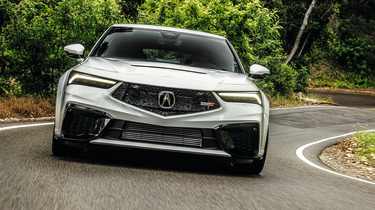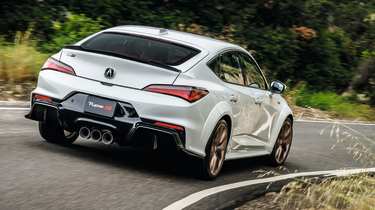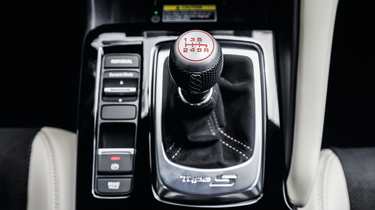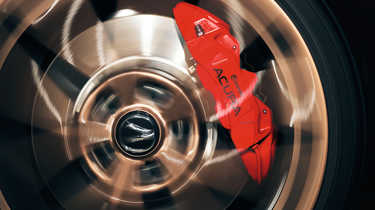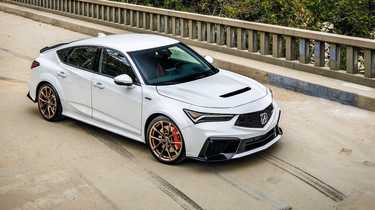Acura Integra Type S 2024 review – a Honda Civic Type R with added restraint
It’s not officially coming to the UK, which is a great shame because this close relation to the Civic Type R is every bit as brilliant in its own way
Effort and reward are at the very heart of what most of us love about cars. Not just our own effort. The obsession with extracting the most from a car, or just making it flow with economical grace, one apex to the next in a wonderfully easy equilibrium, is a naval-gazing but endlessly diverting pursuit, sure. But, very often, feeling and harnessing the effort of the car itself is the reward. Hearing a momentary flare of wheelspin over a mid-corner bump just as the engine hits the sweet spot and the chassis is stretched right to the very limit… well, it’s just bloody good fun. I think it can be boiled down to intensity. We want to be there, in that moment, orchestrating the car’s effort and immersed in the intensity of it all.
Maybe that’s why it’s hard to fall under the spell of EVs. The soundtrack of a conventional car is like the heartbeat, ramping up and up as every other element of the car is stretched to the limit. It underpins the whole experience and without it everything is less vivid. Anyway, let’s not turn this into an EV lament. The point is that this magical zone where a car is at full load, full noise and still hanging in there with accurate response and unbreakable control isn’t dependent on power, engine placement, even which axle is driven. It’s why a Peugeot 106 GTi can get you to similar places to, say, a Porsche 911, or an Impreza RB5 or a McLaren 750S. The experience is different but the thrill of the chase and the sense of awe as the car deploys its all under your instructions is basically what has fed this magazine for 25 years. Effort and reward.
> Honda Civic Type R (FL5) review: the undisputed king of hot hatches
The Honda Integra Type S – sadly another car we miss out on in the UK – gets it. We can delve into the numbers in a moment, but what’s important is that this subtler sibling to the Civic Type R delivers, both in the everyday-accessible ways – for example the fantastic manual gearbox and the consistency of controls – and when you push well beyond what might be feasible on every journey. It goes with you, bristling with aggression and titanium-fisted control. The helical limited-slip differential gives the front axle stunning purchase and opens up quite amazing mid-corner possibilities just when you think you should be running out of options. The four-cylinder 2-litre turbocharged engine doesn’t sing, but it combines an all-business muscularity with a properly eye-widening top end. The car just feels absolutely on it. No compromise, no excuses. It’s superb.
I called it a Honda, didn’t I? Well, it’s badged an Acura but it is a Honda in all the ways that count. It shares its platform and suspension architecture with the Civic Type R and has the same wheelbase, same track widths and even the same electronically adjustable dampers. That means a trick dual-axis front set-up to reduce torque-steer and, of course, the aforementioned and excellent helical limited-slip differential. The 2-litre turbocharged four-cylinder engine is similar, too. It’s tweaked slightly to deliver a peak of 320bhp at 6500rpm and 310lb ft from 2600 to 4000rpm, and due to slightly more relaxed US regulations the exhaust is a little bit naughtier in Sport+ mode than the Civic’s. The only gearbox available for the Type S is the six-speed manual also found in the Type R. No complaints here.
Even so, the Integra Type S is generally positioned as a slightly more restrained proposition to the Civic. Acura is Honda’s ‘luxury’ brand in the US and hence the Type S gets more sound-deadening, revised damper tuning with less aggressive rebound, and different anti-roll bars, while the exterior doesn’t shout quite as loudly about its hardcore credentials. There’s no +R mode, either. The Integra Type S features Comfort, Sport, Sport+ and Individual settings.
During the launch phase of the Integra Type S, engineers suggested that the Civic Type R was more of a track-focused car, whereas the Type S was more about ‘emotion’ and road thrills. We’ve found the Civic’s only real weakness to be a very aggressive ride that can feel a little too much on the UK’s roads, so perhaps the Integra will be an even sweeter compromise. There’s a mild price bump to $51,800, up from the Type R’s $44,795 in the US market, and although the Integra is heavier, the penalty is only 14kg for a total of 1463kg (using Honda and Acura US official ‘curb weight’ figures, which include all fluids and a full tank of fuel).
First impressions are very good indeed. The Type S looks low, wide and with a lovely economy of line. Perhaps it lacks the pure JDM-style aggression of the Civic Type R, but the Acura has its own flavour, mixing sophisticated proportions with fun details like the triple megaphone-exit exhaust. Inside, there’s a strong sense of familiarity, too, despite the odd-looking badge. The driving position is a little higher than expected and the smooth metal Type R shifter is now leather-trimmed (all the better in the California sunshine to avoid a burnt palm. Or a frozen one in the UK), but the smells and textures and the feel of the controls are pretty Honda-esque. Perhaps the perceived quality is a notch higher, but we’re talking degrees here.
On the move that uncanny Civic-style familiarity extends to the fundamental rightness of the Type S. The gearshift remains a highpoint – so tight, precise and with a milled-from-billet integrity – but every move the Integra makes has a consistency and weighting that’s shot-through with quality. The steering gets a little heavy as you click up to Sport+ mode but playing with the Individual setting restores a more fitting deftness that matches the easy agility of the chassis. Is the ride a revelation? No, I think that’s too strong a statement. The Type S remains a firm-riding car at all times, but the dampers do relax the ride just enough to make a difference without sacrificing control. In fact, the Type S is brilliantly composed and eats up direction changes with the wheels and body kept completely in check.
Sadly, your own body isn’t quite so well locked down. In fact, the support of the seats is pretty awful in absolute terms and utterly criminal in comparison to the superb chairs found in the Civic Type R. The Integra puts you in touch with the road and at the centre of a sharp-edged driving experience, but asks you to cling onto the steering wheel for grim death, which naturally masks some of the feedback that you’d otherwise enjoy. It’s a pretty startling oversight and the one big weakness in the Type S experience.
Luckily, the overall quality of the Type S experience still shines. The engine is strong and characterful with a really sharp top end. As we’ve discussed before with the Civic, the 2-litre turbocharged unit has the feel of a sharp, naturally aspirated engine with the muscle of forced induction as a bonus. A bespoke unit rather than a mundane engine boosted-up to deliver competitive numbers. The gearbox is always enthralling and the rev-match function works really well too, its speed and aggression increasing organically as you explore the driver modes.
Layer on top of that the Integra’s remarkably quick responses but eerie sense of stability and the dynamic picture is very special indeed and creates a really exciting energy. You hustle the Type S, punching it from one corner to the next with real intent, leaning on the excellent brakes and chasing the throttle hard and early.
The helical diff is quite the party piece, dragging the nose towards each apex and resisting wheelspin with real tenacity. It’s actually most effective on the sort of challenging, ragged tarmac familiar to us in the UK. On really smooth sections it is possible to get too greedy with the throttle, overwhelming the front tyres and instantly locking the diff, which in turn skates the front end wide as both wheels spin freely.
For the most part, though, the Integra simply follows your lead. More commitment equals more bite, more throttle magics-up greater traction, and the harder you hit the shifter, the sweeter the resultant gearchange. It’s a liberating experience and, despite the extra weight over a Civic Type R and slightly softer suspension, the Integra is blessed with immediacy. It’s not a car that asks you to unravel a road or corner bit-by-bit. You fire it along as fast as your hands and feet can move, wringing its neck and matching the car’s effort with your own.
On track, the slightly different brief does show. Where the Civic might snap into a corner with some yaw angle to lock it on line, the Integra generally feels more neutral and there’s not a great deal of playfulness in dry conditions. It’s efficient, and the strong traction and keen, highly responsive engine make for fast progress. For the occasional trackday the Integra would be highly enjoyable. It just lacks that last degree of sharpness that defines the Civic Type R and the stability control system refuses to disappear completely, which means you can’t really explore different cornering styles by pitching the car hard on the brakes. The engine temperature starts to rise pretty quickly on track, too.
The tech and infotainment? It seemed okay, but I didn’t really pay it too much attention. Perhaps that’s a dereliction of duty but it’s also telling. You tend to focus on touchscreens when the car as a whole is frustrating, or it feels like the driver modes are crucial to unlocking the car’s best self. In the Integra, you simply jump in and everything feels pretty much on the button straight out of the box. Plus, being occupied with a manual gearbox means you don’t worry too much about menus and mood settings for interior lights…
So, the Integra Type S is exactly as pitched. A quieter, more considered take on the Type R formula that retains much of the Civic’s steel but smooths away some of the harshest edges and dials back the track focus. Somehow that summation doesn’t do the car justice, though. For while it might lack the touring car-style demeanour of the full-fat Type R, there’s such a sense of quality and care to the dynamics that it’s very rare you feel short-changed.
I think much of this stems from the straightforwardness of the whole car. Short on gimmicks, big on interaction and engagement, the Integra is a really rewarding car to drive at all times and never feels stretched and contorted out of its comfort zone, even under extreme provocation. It’s just a bloody good, old-fashioned hot hatch in a grown-up suit. Who doesn’t want that?
Acura Integra Type S specs
| Engine | In-line 4-cyl, 1996cc, turbocharged |
| Power | 320bhp @ 6500rpm |
| Torque | 310lb ft @ 2600-4000rpm |
| Weight | 1463kg (222bhp/ton) |
| Tyres | Michelin Pilot Sport 4 S |
| 0-62mph | 5.4sec |
| Top speed | 167mph |
| Basic price | See text |
This story was first featured in evo issue 321.

